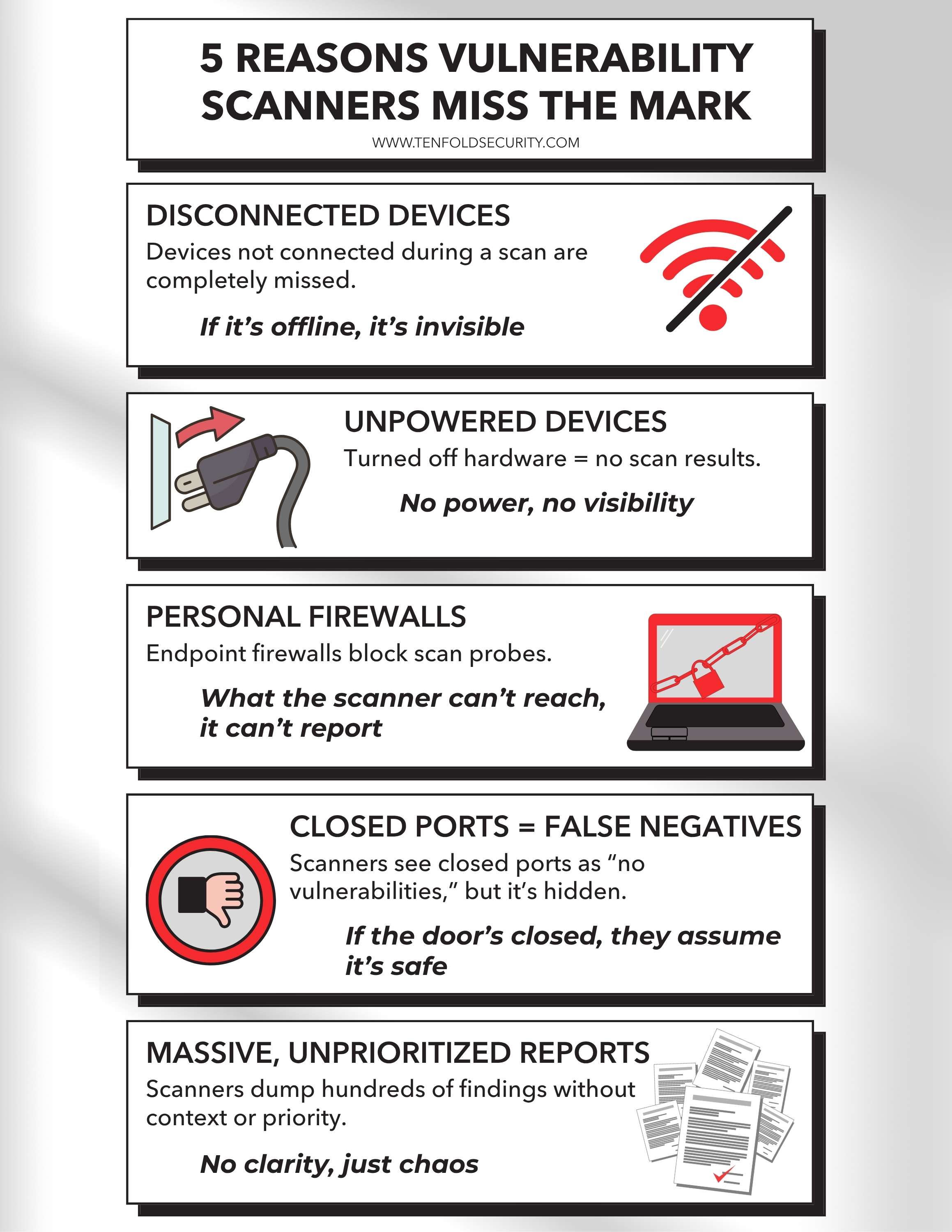5 Major Problems with traditional Vulnerability Scanning


Table of contents
Introduction: Vulnerability Scanning is Outdated
5 Core Weaknesses of Traditional Scanning
- Disconnected Devices
- Unpowered Devices
- Personal Firewalls
- Closed Logic Ports
- Bloated, Confusing Reports
Credentialed Scanning: A Risk in Itself
The Reality: Threats Have Evolved, Scanners Haven't
A Smarter Solution: Active Penetration by Tenfold Security
Introduction: Vulnerability SCanning is Outdated
Vulnerability scanners have been used for over 25 years, but not much has changed—except the threats you're up against. You might run a scan, get a report, and pass it on to IT. But does it actually keep your business secure?
Spoiler: it doesn't.
5 Core Weaknesses of Traditional Scanning
1. Disconnected Devices are Invisible
If a laptop or server isn't connected at the time of the scan, it won't be scanned. That means blind spots.
2. Unpowered Devices Get Ignored
Offline devices like servers under maintenance or systems powered down overnight don't get included in vulnerability scans.
3. Personal Firewalls Block Traffic
Devices with local firewalls that reject external connections appear "clean"—even when they aren't.
4. Closed Logical Ports Hide Risk
If a port isn't open during the scan, the scanner assumes there are no vulnerabilities tied to that service or application.
5. Bloated, Unclear Reports
Scanners often generate reports with hundreds of entries scored 1-10, offering no real prioritization. What should you fix first? What can wait?

Credentialed Scanning: A Risk in Itself
To scan web apps and internal tools effectively, scanners need login credentials. That means storing your admin logins in a third-party tool.
Risk: If the scanner is compromised, attackers gain keys to your most sensitive systems.
The Reality: Threats Have Evolved, Scanners Haven't
According to CrowdStrike's 2025 Global Threat Report:
"79% of detections were malware free–driven by hands-on-keyboard techniques and stolen credentials" - CrowdStrike 2025 Global Threat Report
This means most modern attackers aren't exploiting vulnerabilities. They're logging in like users, blending into your traffic, and avoiding detection entirely.
Traditional scanners can't detect this.
A Smarter Solution: Tenfold Security's Active Penetration Testing
Tenfold Security offers an Active Penetration Testing (APT) platform that overcomes these traditional limitations:
- Continuously scans—not just once a quarter
- Validates results to reduce false positives
- Prioritizes risk based on your business context
- Finds weaknesses scanners miss, including user behavior risks

What's Next: AI-Powered APT is Coming Soon
We're taking APT to the next level with AI-driven attack simulations. Our new platform will make traditioinal scanning and even manual pen tests obsolete.
Coming soon from Tenfold Security—where automation meets active defense.
Conclusion: Rethinking Vulnerability Management
Vulnerability scanners aren't enough. They're outdated, incomplete, and blind to how modern attackers operate. It's time to go beyond the checklist and adopt smarter, continuous security solutions that actually work.
ready to elevate your cybersecurity strategy?

Stay ahead of threats with Tenfold Security. Don't miss our upcoming resource: The Ultimate Guide to Cybersecurity for SMBs.
This comprehensive guide will equip you with everything you need to protect your business from cyber threats.
Sign up now to be notified the moment it's available and gain exclusive early access.


